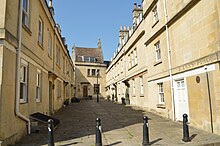The Sack of Bath
The original newspaper pieces that the book comprises inspired a resurgence in architectural conservation in the United Kingdom and gave additional strength to the Bath Preservation Trust.
An example of this style is Fergusson's claim that the redevelopment efforts caused more damage to the city's architecture than the Bath Blitz of 1942.
Fergusson argues that even unremarkable historic houses ought to be preserved because they create the context or "frame" for more notable listed buildings.
[3] As he puts it, "The set pieces—Royal Crescent, the Circus, Milsom Street, the Pump Room, and so on—stand glorious and glistening (some have been restored and cleaned) for tourists to come and see in their thousands every year.
"In contrast, Fergusson critiques attempts at making modern, "packing case" buildings fit in with Georgian architecture by facing them with yellow Bath stone.
[6] Fergusson agrees that Bath needed rehabilitation but thought that the city seemed to ignored the potential benefits of historical architecture.
He thought that many of the destroyed buildings could easily have been rehabilitated for a price similar to the new constructions: "Thus property which could and should have been modernised has been declared unfit and allowed to fall to pieces.
[8]The Sack of Bath has been compared by conservationists to other British books of polemic against development that were also published in the 1970s, like The Rape of Britain and The Erosion of Oxford.
